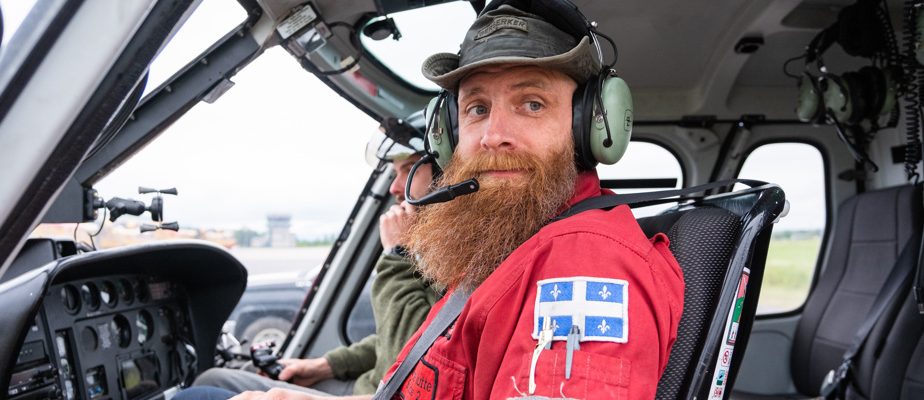(Roberval) 7:30 a.m. About ten people in garish orange uniforms gather around Patrice Charest. Regular firefighters as well as new faces who come to reinforce the team.
For two days, these firefighters have been fighting the fire noh 436, raging north of Lac Saint-Jean. It is not very big, but it was considered a priority because it is not very far from the village of Saint-Stanislas. The noh 436 is one of 35 fires, out of 132, that are fought by firefighters from the Society for the Protection of Forests against Fire (SOPFEU) across the province.

PHOTO CHARLES WILLIAM PELLETIER, THE PRESS
Team meeting at the start of the day
Firefighters arrived on Tuesday to contain this fire caused by lightning which was previously considered “out of control”. On Wednesday, the fire was brought under control. And Thursday, the goal was to extinguish it once and for all to protect an outfitter and residences further south.
“When we arrived on the initial attack [mardi matin], it was all smoking,” explains Patrice Charest, pointing to a fire covering 24 hectares, 436, on a map. “The winds were very strong, they were erratic, they came from the northeast and northwest,” says the chief wrestler with his long red beard and his cowboy hat. His voice is partly drowned out by the noise of the air tanker engines.

PHOTO CHARLES WILLIAM PELLETIER, THE PRESS
The fire noh 436 was deemed a priority because of its proximity to the village of Saint-Stanislas.
A group of firefighters approached the blaze from a forest road, then they were transported even closer to the blaze by helicopter.
“In the forest, the organization is not like that of a city firefighter,” explains Josée Poitras, SOPFEU communications officer. With large fires, we must first build helipads in the forest to teleport our forest firefighters. »

PHOTO CHARLES WILLIAM PELLETIER, THE PRESS
Two air tankers participated in the effort.
With large hoses, the firefighters drew water from a stream and surrounded the fire. They aimed the jet one meter into the fire and one meter out of it. Two air tankers participated in efforts to lower the height of the flames.

PHOTO CHARLES WILLIAM PELLETIER, THE PRESS
Patrice Charest giving information to his team
It’s a fire that could have eaten a lot more wood. The 30 hectares could have become 5000 hectares.
Patrice Charest, SOPFEU fight leader
Just two weeks ago, Patrice Charest was fighting fires in Alberta. He was called back urgently with the outbreak of forest fires in Quebec.

PHOTO CHARLES WILLIAM PELLETIER, THE PRESS
Helicopter pilot Jonathan Beaumont
“Everything was there for it to make a big fire,” adds helicopter pilot Jonathan Beaumont, who normally works for a drilling company. As travel in the forest is now prohibited, his contracts have been interrupted and he has offered a helping hand to SOPFEU like some of his colleagues.
“The fire, we have mastered it. This morning I know it is correct. He’s sleeping and he won’t surprise me,” adds Patrice Charest in a satisfied tone.
control the uncontrollable
During large fires, the aeropointer is essential to manage the movements of tankers and helicopters, says Jonathan Beaumont. This small device flies over operations at height and directs air traffic.
“It’s like a control tower in the air. It takes that when you start having four, five, six, seven helicopters and air tankers. […] We are told which direction to take,” explains the pilot, who has 15 years of experience.

PHOTO CHARLES WILLIAM PELLETIER, THE PRESS
The SOPFEU team left from Roberval regional airport.
To stop the blazes, the other method often used is the “mechanized line,” adds Mr. Charest. The words “trench” or “fire wall” are often used in the media to refer to this strategy. In Chibougamau and Lebel-sur-Quévillon, this tactic is currently used.
“These are not really trenches as we imagine them. a bulldozer [engin à chenilles qui pousse la terre] and a digger truck clear the way. They remove all the fuel so that only earth, sand or clay remains on the ground”, explains the head of the fight. When the fire arrives in front of the corridor without plants about ten meters wide, it has nothing left to burn in its path and it dies.
Patrice Charest has extinguished hundreds, even thousands of fires in his 20-year career at SOPFEU. He has rarely seen fires come so close to communities, towns and cities, except perhaps in 2005, he says.
“I’ve been a shadow worker for 20 years,” he smiles. “But I don’t do this job for recognition,” he hastens to clarify.
“What I like is to control an uncontrollable element. A fire is uncontrollable, and you tell him: “No, you’re not going there. You stop there.” Sometimes it works and sometimes it doesn’t. But when it works, you’re proud of yourself. »
